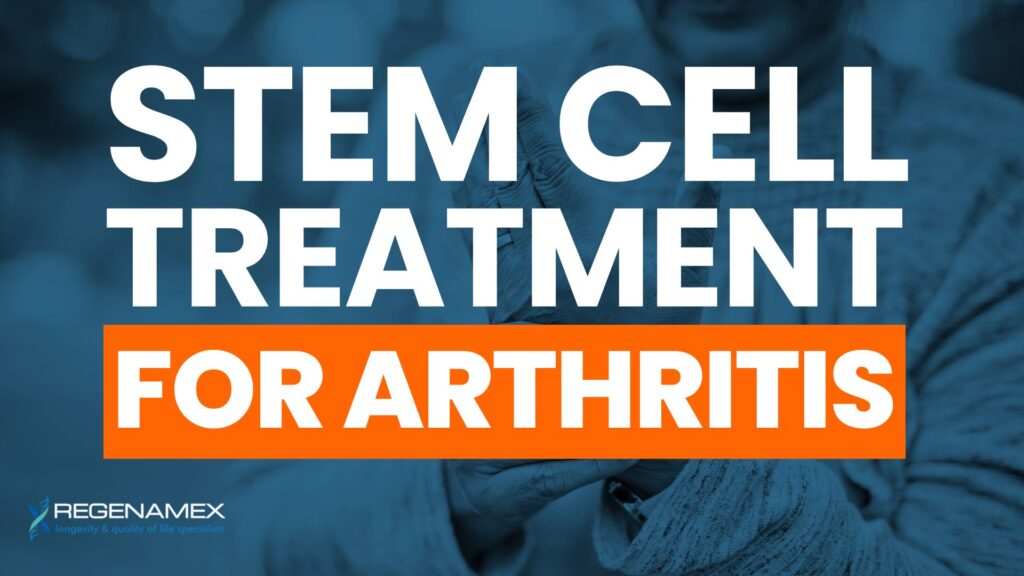
Arthritis Treatment with Stem Cells
Arthritis treatment with stem cells is redefining how patients manage chronic joint pain and stiffness. Instead of relying solely on painkillers, cortisone shots, or invasive surgeries, regenerative medicine now provides options that target the root causes of arthritis. Mesenchymal stem cells (MSCs), derived from ethically donated placental tissue and Wharton’s jelly, offer powerful anti-inflammatory and regenerative properties. These cells help repair cartilage, reduce inflammation, and improve mobility, making them a promising solution for millions of people struggling with arthritis.
At Regenamex, a licensed regenerative medicine clinic in Mexico with locations in Puerto Vallarta and Tijuana, arthritis patients from around the world are receiving advanced MSC therapies under strict COFEPRIS regulation. With state-of-the-art facilities, ethical sourcing, and complementary treatments like PRP, exosomes, and IV nutrition, Regenamex has become a trusted destination for those seeking safe, affordable, and effective arthritis stem cell treatment.
Understanding Arthritis and Its Challenges

Arthritis is one of the most common chronic conditions affecting millions worldwide, yet it is often misunderstood. It isn’t just a single disease but rather an umbrella term that includes more than 100 different conditions. Among the most prevalent are osteoarthritis, which occurs when the cartilage cushioning joints wears down; rheumatoid arthritis, an autoimmune disorder where the immune system mistakenly attacks joint tissues; and psoriatic arthritis, which is linked to psoriasis and causes painful joint inflammation. Despite their differences, these conditions share a devastating commonality: they progressively damage the joints, leading to pain, stiffness, swelling, and decreased mobility. Over time, the constant inflammation and tissue degeneration significantly reduce a person’s quality of life, making everyday tasks like walking, climbing stairs, or even opening jars difficult.
Traditional treatment approaches are often limited to symptom control rather than true repair. Doctors frequently prescribe pain medications or anti-inflammatory drugs, which may temporarily ease discomfort but do little to halt disease progression. Physical therapy and cortisone injections can help in the short term, but repeated use often diminishes their effectiveness. In advanced cases, surgery such as joint replacement may be the only recommendation, yet this comes with significant risks — from infection and blood clots to long recovery periods and prosthetic failure after 10–15 years. These limitations highlight the urgent need for a therapeutic option that does more than mask symptoms. This is where stem cell therapy for arthritis is gaining traction, as it offers a regenerative approach designed to address the root causes of joint damage.
How Stem Cell Therapy for Arthritis Works
Stem cell therapy for arthritis harnesses the unique regenerative properties of mesenchymal stem cells (MSCs), which are considered the body’s natural repair agents. Unlike traditional medications that focus on reducing pain signals, MSCs actively work to heal damaged tissues. They can differentiate into cartilage, bone, and muscle cells, making them ideal for repairing joints affected by arthritis. When precisely injected into arthritic joints, these cells release powerful bioactive molecules, including growth factors and cytokines, that calm inflammation, stimulate cartilage repair, and encourage new tissue growth. This process improves lubrication within the joint, enhances shock absorption, and reduces the friction that causes pain.
What makes MSC therapy particularly innovative is its dual role in both symptom management and disease modification. Not only do patients often experience rapid pain relief and increased mobility, but they may also benefit from longer-term improvements as the therapy addresses the biological damage inside the joint. At Regenamex, MSCs are sourced exclusively from ethically donated Wharton’s jelly and placental tissue, which are known for their potency and safety. These cells are processed under strict COFEPRIS regulation, ensuring sterility and consistency. Unlike cortisone injections that wear off quickly, stem cell therapy can provide lasting benefits by repairing tissues and rebalancing the immune system to slow the progression of arthritis.
Benefits of Arthritis Stem Cell Treatment

The advantages of arthritis stem cell treatment extend far beyond temporary relief, offering patients hope for long-term restoration of mobility and comfort. One of the most notable benefits is that it provides a non-surgical alternative for individuals hesitant about or unfit for joint replacement surgery. Because the treatment is minimally invasive, recovery time is dramatically shorter than with surgical interventions, allowing most patients to resume normal activities within days. Moreover, MSC therapy taps into the body’s own healing capabilities, reducing reliance on medications that can cause side effects like stomach ulcers, kidney problems, or dependency.
Another key benefit is personalization. At Regenamex, each patient undergoes a detailed consultation and imaging studies so that treatment protocols are tailored to their unique condition. This ensures that the right dose and delivery method are chosen for maximum effectiveness. Many patients report improvements in flexibility, reduced stiffness, and a significant decrease in daily pain levels. Beyond physical benefits, regaining independence and mobility has a profound impact on emotional well-being. Patients often describe feeling renewed hope and freedom as they return to favorite activities — from gardening and walking to playing with grandchildren — without the limitations that arthritis once imposed.
Why Stem Cell Therapy in Mexico Is Gaining Global Attention
Stem cell therapy in Mexico is quickly becoming an attractive option for international patients, particularly those from the U.S. and Canada where access is often limited. In many Western countries, arthritis stem cell treatment is classified as “experimental” and therefore unavailable outside of clinical trials. Mexico, however, has established a regulatory environment through COFEPRIS that allows patients to receive advanced therapies while ensuring quality and safety standards comparable to international benchmarks. This means patients can access cutting-edge regenerative care without the long waiting lists or prohibitive restrictions they might face at home.
Regenamex, with clinics in Puerto Vallarta and Tijuana, has become a leader in this field by combining ethical sourcing, transparent practices, and state-of-the-art facilities. Patients not only benefit from COFEPRIS oversight but also from significant cost savings — treatments are often 50–70% less expensive than in the U.S. Beyond affordability, Regenamex integrates complementary therapies such as PRP, HGH, exosomes, and IV nutrition to enhance results. Their Fly & Buy program further simplifies the process, offering logistical support for international patients. This unique combination of innovation, affordability, and patient-centered care explains why Mexico is becoming a hub for regenerative arthritis treatment.
Patient Experience at Regenamex

The journey of receiving arthritis stem cell treatment at Regenamex is designed to be supportive, transparent, and stress-free. The process begins with a thorough consultation in which medical history, current symptoms, and diagnostic imaging are reviewed. Based on this information, a personalized protocol is developed that specifies the type of stem cell delivery and dosage best suited to the patient’s condition. This individualized approach ensures that no two treatments are the same, reflecting the clinic’s commitment to patient-specific care.
On the day of treatment, stem cells are processed under sterile GMP-certified conditions with COFEPRIS oversight, guaranteeing the highest standards of safety and quality. Injections are performed with precision using imaging guidance to ensure accurate placement in the affected joints. Most patients describe the procedure as quick and relatively comfortable, with minimal downtime. Recovery is typically rapid, with patients resuming normal activities within days. Follow-up appointments and aftercare are built into the program to monitor progress, answer questions, and ensure that patients are achieving the best possible outcomes. This comprehensive, patient-centered process sets Regenamex apart as a trusted provider of stem cell therapy in Mexico.
Long-Term Outlook
The long-term outlook for patients undergoing arthritis treatment with stem cells is encouraging, offering possibilities that traditional treatments cannot. Unlike medications or cortisone shots, which must be repeated indefinitely, stem cell therapy has the potential to deliver lasting results by repairing damaged tissues and slowing disease progression. Many patients report experiencing pain relief and improved mobility for months or even years following treatment, with some delaying or completely avoiding the need for joint replacement surgery.
Of course, individual results vary depending on the severity of arthritis, overall health, and lifestyle choices. Patients who maintain a healthy weight, stay physically active, and follow aftercare recommendations often enjoy the most sustained improvements. While stem cell therapy is not a guaranteed cure, it represents a paradigm shift in arthritis management, moving from symptom suppression toward true regeneration. For those facing the daunting prospect of surgery, this therapy provides hope for maintaining mobility, independence, and quality of life through a safe, minimally invasive approach.
FAQs: Arthritis Treatment with Stem Cells
Arthritis treatment with stem cells is a modern regenerative approach that uses mesenchymal stem cells (MSCs) to restore joint health. These cells are often described as the body’s “master repair cells” because they can transform into cartilage, bone, and other musculoskeletal tissues. When delivered directly into arthritic joints, they reduce inflammation, stimulate the repair of damaged cartilage, and encourage natural joint lubrication.
The process of stem cell therapy for arthritis is rooted in the ability of MSCs to communicate with the body’s immune system and damaged tissues. Once injected, these cells release bioactive molecules such as cytokines and growth factors that calm overactive immune responses. This reduces chronic inflammation that contributes to stiffness and pain. At the same time, stem cells encourage cartilage cells to repair themselves and stimulate the growth of new tissue in areas that have deteriorated.
Safety is one of the biggest concerns for anyone exploring regenerative medicine, and arthritis stem cell treatment has an excellent track record when performed under proper regulation. At Regenamex, all procedures are carried out in compliance with COFEPRIS, Mexico’s equivalent of the FDA. This means the cells are sourced ethically, processed under Good Manufacturing Practice (GMP) standards, and delivered using sterile techniques to minimize risk.
Stem cell therapy in Mexico has shown benefits for a wide variety of arthritic conditions. Osteoarthritis, the most common form, responds particularly well as stem cells help regenerate worn cartilage and reduce bone-on-bone friction. Rheumatoid arthritis patients may also benefit, as MSCs have strong immunomodulatory effects that calm the overactive immune system responsible for joint attacks.
The duration of results from arthritis stem cell treatment depends on several factors, including the severity of the disease, the patient’s age, and their lifestyle. Many patients experience significant relief that lasts for months, while others report improvements extending for years. Unlike cortisone injections, which wear off quickly, stem cells continue working in the joint long after treatment by repairing and stabilizing tissues.
One of the reasons so many international patients travel for stem cell therapy in Mexico is the cost advantage. On average, arthritis treatment with stem cells in Mexico is 50–70% less expensive than similar procedures in the United States. Despite the lower price, patients do not sacrifice quality; COFEPRIS-regulated clinics like Regenamex maintain world-class standards of safety and efficacy.
Regenamex also makes the process easier through its Fly & Buy program, which bundles treatment with travel support and aftercare. This transparency in pricing allows patients to plan their treatment without hidden surprises, making stem cell therapy in Mexico an accessible option for those who may have been priced out in their home countries.

